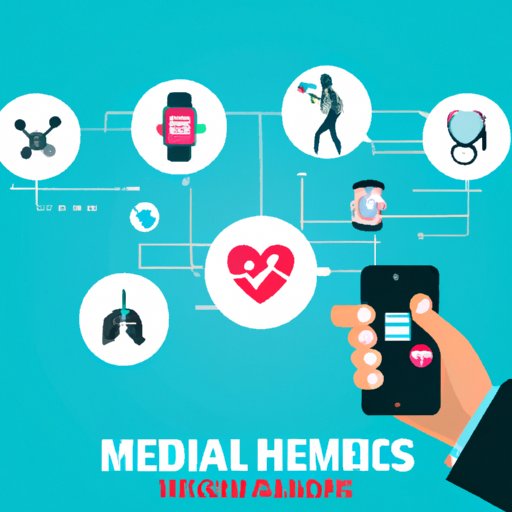Introduction
Mobile health technology is an emerging field that utilizes mobile computing and communication technologies to improve access to healthcare services and enhance patient engagement. The purpose of this article is to provide an overview of mobile health technology, examine its benefits and challenges, and investigate its impact on healthcare delivery.
An Overview of Mobile Health Technology
Mobile health technology (mHealth) is a rapidly evolving field that has the potential to revolutionize healthcare delivery by providing more efficient, cost-effective, and accessible care. According to the World Health Organization, mHealth “refers to medical and public health practice supported by mobile devices, such as mobile phones, patient monitoring devices, personal digital assistants, and other wireless devices.”
Mobile health technology encompasses a wide range of tools and applications, including mobile apps, wearable devices, and telemedicine. Mobile apps are software programs designed to run on smartphones or tablets and can be used to track health data, monitor symptoms, access health information, and connect with healthcare providers. Wearable devices use sensors to measure and collect data about a person’s health status, activity levels, and vital signs. Telemedicine uses telecommunications technology to provide remote clinical services, such as virtual doctor visits and remote patient monitoring.
Examining the Benefits of Mobile Health Technology
Mobile health technology offers numerous benefits, including improved access to care, increased efficiency, enhanced patient engagement, and reduced costs. Improved access to care is one of the most significant advantages of mHealth. By enabling patients to access healthcare services from anywhere at any time, mHealth eliminates traditional barriers to care, such as distance and cost. This is particularly beneficial for rural communities and underserved populations, who often lack access to quality healthcare services.
Mobile health technology also increases efficiency by streamlining administrative tasks and reducing paperwork. For example, electronic health record (EHR) systems enable healthcare providers to share patient data more quickly and easily, resulting in faster diagnosis and treatment. Additionally, mHealth enhances patient engagement by providing patients with more control over their own health. Through mHealth platforms, patients can access their own health data, track their progress, and communicate directly with their healthcare providers.
Finally, mHealth reduces costs by eliminating the need for costly office visits and reducing administrative costs. Additionally, mHealth enables healthcare providers to reach more patients, which can increase revenue while decreasing overhead expenses.

Exploring the Challenges and Opportunities of Mobile Health Technology
While mobile health technology offers numerous benefits, it also presents a number of challenges and opportunities. Security risks are a major concern with mHealth, as sensitive patient data is vulnerable to unauthorized access and misuse. In addition, privacy concerns are another issue, as mHealth platforms may not always comply with applicable privacy laws.
There is also the potential for misuse of mHealth technologies. For example, if patients use mHealth platforms to self-diagnose, they may not receive proper medical care or follow-up treatments. To address these issues, mHealth developers must ensure that their products are secure, private, and properly regulated.
Despite these challenges, there is also a great opportunity for innovation in the mHealth field. Developments such as artificial intelligence (AI)-based diagnostic tools and blockchain-enabled patient data sharing have the potential to revolutionize healthcare delivery.

Comparing Different Types of Mobile Health Technologies
Mobile health technology encompasses a variety of tools and applications, including mobile apps, wearable devices, and telemedicine. Mobile apps are the most common type of mHealth technology and can be used to track health data, monitor symptoms, access health information, and connect with healthcare providers. Wearable devices use sensors to measure and collect data about a person’s health status, activity levels, and vital signs. Finally, telemedicine uses telecommunications technology to provide remote clinical services, such as virtual doctor visits and remote patient monitoring.
Investigating the Impact of Mobile Health Technology on Healthcare Delivery
The rapid proliferation of mobile health technology has had a profound impact on healthcare delivery. Studies have shown that mHealth can improve health outcomes by providing timely access to care and facilitating early detection and treatment of diseases. Additionally, mHealth can increase patient satisfaction by improving communication between patients and healthcare providers. Finally, mHealth can improve the quality of care by providing access to real-time data and allowing for more accurate diagnoses and treatments.

Assessing the Future of Mobile Health Technology
The future of mobile health technology is bright, with technological advancements and global expansion driving further growth. Advances in machine learning and AI will enable mHealth platforms to provide more accurate and personalized recommendations, while developments in 5G networks and cloud computing will give rise to new applications and services.
Regulatory frameworks must also keep pace with technological developments in order to ensure the safety and effectiveness of mHealth products. Finally, mHealth technologies are increasingly being adopted in developing countries, where they can help bridge the gap between rural and urban areas and provide access to quality healthcare services.
Conclusion
Mobile health technology has the potential to revolutionize healthcare delivery by providing more efficient, cost-effective, and accessible care. This article provided an overview of mobile health technology, examined its benefits and challenges, and investigated its impact on healthcare delivery. While there are security and privacy concerns associated with mHealth, it also presents an opportunity for innovation and has already had a positive impact on healthcare delivery. As technological advancements and global expansion continue to drive further growth, the future of mHealth looks bright.
(Note: Is this article not meeting your expectations? Do you have knowledge or insights to share? Unlock new opportunities and expand your reach by joining our authors team. Click Registration to join us and share your expertise with our readers.)
